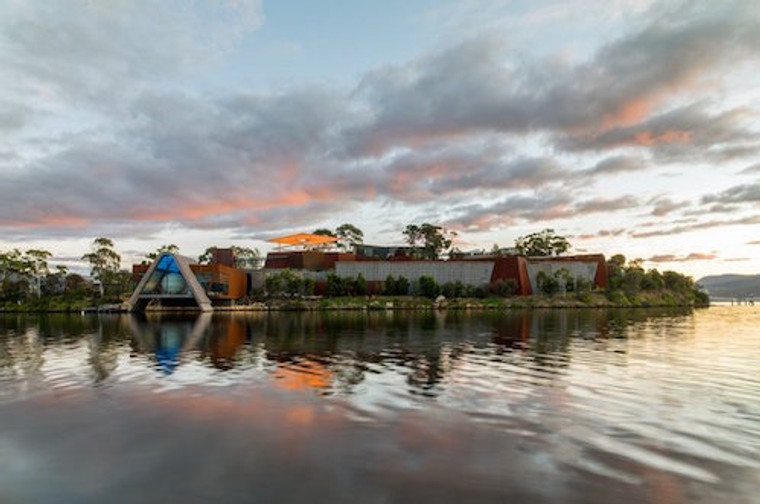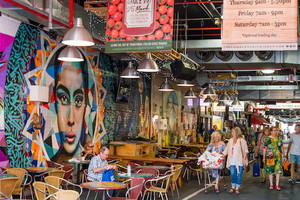
Just say the name “Tasmania” and a lineup of images will spring to mind; sweeping, rugged landscapes, a rich convict history, peculiar wild animals, and pristine forest. If you head south to the formal penal colony, however, you’ll discover there’s a lot more to it than devils and wilderness. These days Tasmania is a cultural hub, as well as a favourite with foodies.
The Museum Of Old And New Art
The state’s capital, Hobart, became officially “hip” when Lonely Planet proclaimed it one of the top 10 city destinations for 2013. Much of the credit at the time could be taken by The Museum of Old and New Art, aka MONA, which opened in 2010 to widespread acclaim. Set in a surreal subterranean complex in the suburb of Berriedale, it is one of Tasmania’s top attractions - and not just for stunning architecture. The museum features works by artists as diverse as Brett Whiteley, Sidney Nolan, Wim Delvoye, Pablo Picasso and Damien Hirst, and hosts special events attracting art lovers from across the globe. Each June the museum hosts DARK MOFO, a festival which “celebrates the dark through large-scale public art, food, music, light and noise”.
Tasmanian Museum And Art Gallery
Another cultural “must-see” for all things art is the Tasmanian Museum and Art Gallery. Located at Dunn Place next to Constitution Dock in Hobart, it’s a traditional museum with special events and permanent exhibitions. One is “Our Changing Land: Creating Tasmania”, a rich collection of objects and stories focussing on the period from the 1800 to 1901, depicting the island’s colourful transformation from the cruel convict settlement of Van Diemen’s Land into the state of Tasmania today. Another is “Our Living Land: Encountering An Upside Down World”, which explores how Tasmania's natural environment has been used to create wealth, advance science and define the state, how Europeans responded to the unfamiliar plants and animals they encountered when they first arrived, and how some species vanished, others prospered and new ones arrived.
Wineries
Although visitors flock to Tasmania for the vibrant cultural and arts scene, they’re also quickly discovering that it’s a foodies’ paradise, with plenty of top quality local cuisine and wine. There are dozens of boutique wineries situated around Hobart within an easy drive of the city; even MONA has its own Moorilla Estate, featuring classic cold climate wines, and the French-accented fine dining restaurant, Source. For a major culinary event, however, head for Tastings at the Top at Cradle Mountain, which this year is held May. A two day festival showcasing the best food and wine from across Tasmania, in the magnificent and dramatic setting of Cradle Mountain, it’s around an hour and a half’s drive from Devonport.
Salamanca Market
No visit to Tasmania is complete without visiting Hobart’s famous Salamanca Market, which is held on the harbour front every Saturday. It’s devoted entirely to local producers, set against the backdrop of historic sandstone houses dating back to the 1800s, and it remains one of Tasmania’s premier tourist attractions. There are around 300 stalls on any given day, selling all manner of items including hand-worked glass, innovative design in Tasmanian timbers, stylish clothing, bespoke jewellery, organic produce, artworks, bath and body care, ceramics and leather goods, handcrafted cheeses, breads, wines and spirits, and delicious hot foods.
Port Arthur
Port Arthur nestles on the southern tip of the Tasman peninsula, around 60 kilometres from Hobart, and it’s home to one of the world’s largest and best preserved nineteenth-century penal colonies, an open air museum, and one of Australia’s most significant heritage sites. The historic site, which is also a World Heritage property, comprises eleven remnant penal sites originally built within the British Empire during the eighteenth and nineteenth centuries on fertile Australian coastal strips. Highlights to explore include the Separate Prison, where flogging gave way to solitary confinement, dating back to 1850, the grounds and gardens of Port Arthur, which make the place less bleak as you’d imagine, and the Penitentiary which is an imposing ruin constructed in 1843 as a flour mill and granary, and which in 1857 was converted into a penitentiary to house over 480 convicts.
- By:
- Joanna Hall
Reviews
-
No So Much Culture
To be honest I prefer the wildlife and great outdoors to the cultural side of Tassie. I enjoy hiking up Cradle Mountain, and I've played golf and been zip lining a couple of times too. Maybe I should give the culture a go sometime though.
-
Love Tassie
I just love visiting Tasmania. I have friends there, which helps, but we always do something new and interesting with every visit, and the art museum is usually on our list depending on what exhibitions are showing. I love the food - very artisan - and it doesn't take long to get out into the wilderness.
-
Love This
I've been to Tassie a few times and twice to Hobart but I've never had time to explore these venues. What great ideas......I have a friend who's an artist who raves about MONA so I should really get back to Hobart and go. Have to say each week you put up some great and very inspirational stuff Ultimate!










